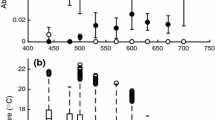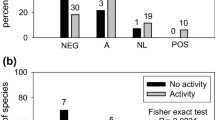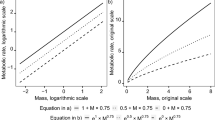Summary
The hypothesis that the ciliary locomotion of rotifers is size limited and that it accounts of a significant portion of the energy budget was investigated using the genera Brachionus and Asplanchna. Speed of movement was measured among clones of different size in Brachionus, which shows little size variation through development. The same tests were done among individuals of different size within a clone of Asplanchna, which shows significant postembryonic size increase. In both cases, relative speed (body lengths per second) decreased significantly as body size increased. On this basis, and ecologically limiting size for ciliary locomotion is proposed. The actual cost of locomotion was measured for Brachionus; it is 62% of total metabolism, even though the theoretical (calculated) power requirements are well below 1% of total metabolism. Ciliary locomotion in the Rotifera thus appears to be extremely inefficient (low ratio of theoretical to actual power requirements). This hypothesis is supported indirectly by the sensitivity of speed to total metabolic rate in Brachionus: both plateau over the temperature range 20–32°C and decline in parallel outside this range. Unexpectedly high actual cost of locomotion is proposed as an important disadvantage of the Rotifera, partly offsetting the advantages accruing to them from small body size.
Similar content being viewed by others
References
Epp RW, Lewis, WM Jr (1979) Sexual dimorphism in Brachionus plicatilis (Rotifera): Its evolutionary and adaptive significance. Evolution 33:919–928
Epp RW, Lewis WM Jr (1980) Metabolic uniformity over the environmental temperature range in Brachionus plicatilis (Rotifera). In: Dumont HJ, Green J (eds) Proceeding of the Second International Rotifer Symposium. Junk, The Hague, pp 145–147
Gilbert JJ (1977) Defenses of males against cannibalism in the rotifer Asplanchna; Size, shape and failure to elicit tactile feeding responses. Ecology 58:1128–1135
Hutchinson GE (1967) A treatise on limnology. Vol 2. Introduction to lake biology and limnoplankton. Wiley, New York
Lasker R (1966) Feeding, growth, respiration and carbon utilization of a Euphausiid crustacean. J Fish Res Bd Can 23:1291–1317
Lewis WM Jr (1979) Zooplankton community analysis. Springer, New York
Sleigh MA, Blake JR (1977) Methods of Ciliary Propulsion and their size limitations. In: Pedley JR (ed) Scale effects in animal locomotion. Academic Press, New York, pp 243–256
Snedecor GW, Cochran WG (1976) Statistical Methods (6th ed.) Iowa University Press, Ames, Iowa
Vlymen WJ (1970) Energy expenditure of swimming in copepods. Limnol Oceanogr 15:348–356
Zeuthen E (1971) Rate of living as related to body size in organisms. Poliske Archiwum Hydrobiologii 17:21–30
Author information
Authors and Affiliations
Rights and permissions
About this article
Cite this article
Epp, R.W., Lewis, W.M. Cost and speed of locomotion for rotifers. Oecologia 61, 289–292 (1984). https://doi.org/10.1007/BF00379624
Received:
Issue Date:
DOI: https://doi.org/10.1007/BF00379624




